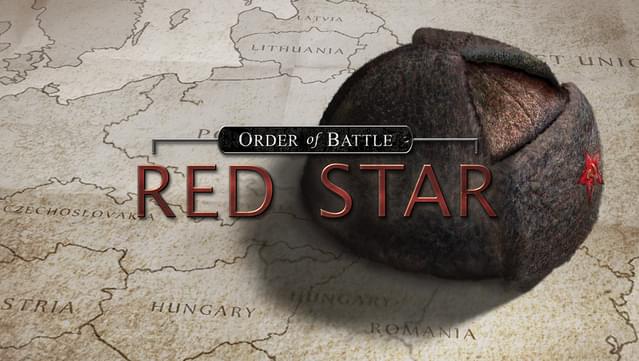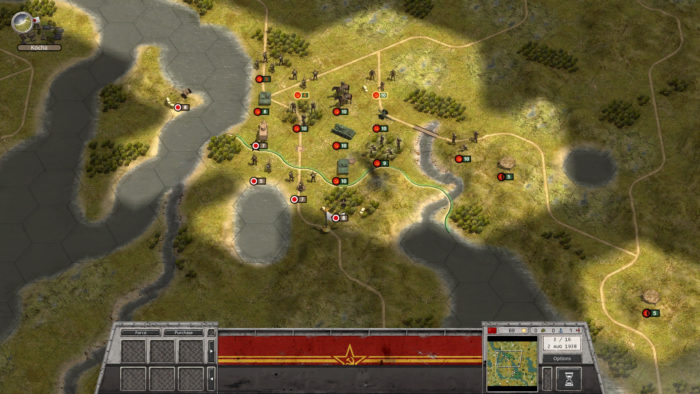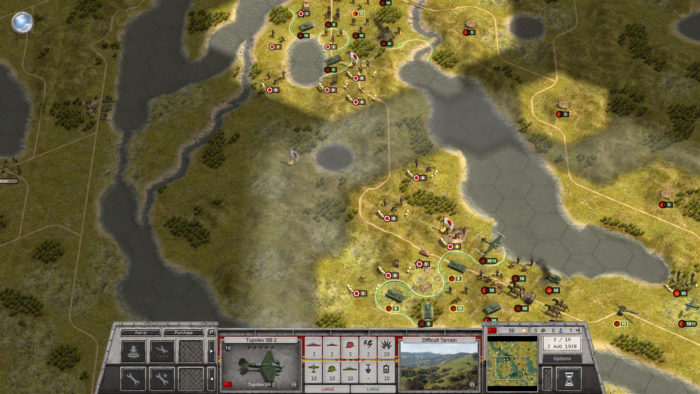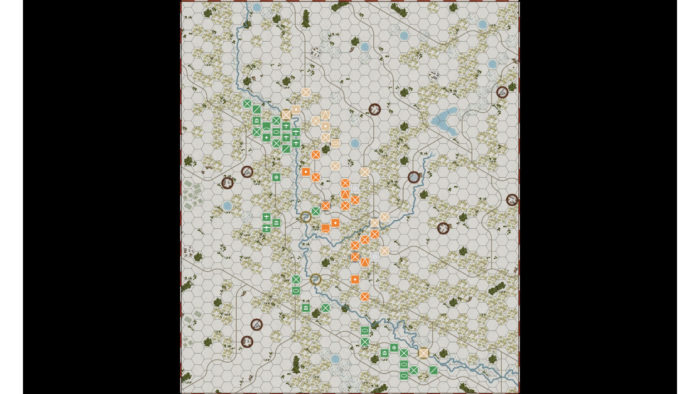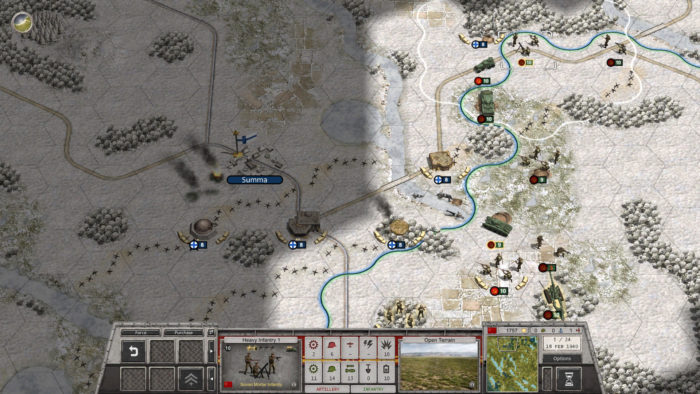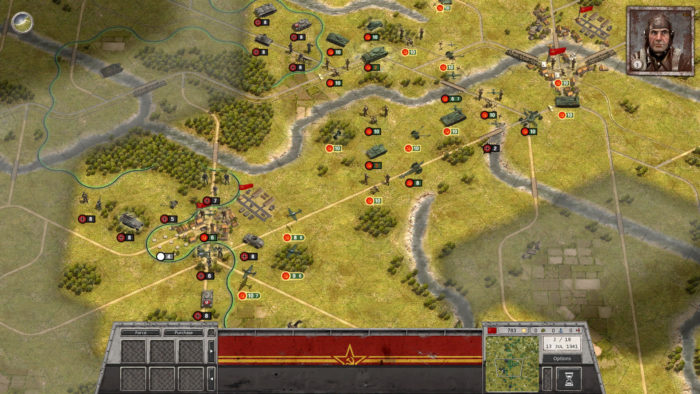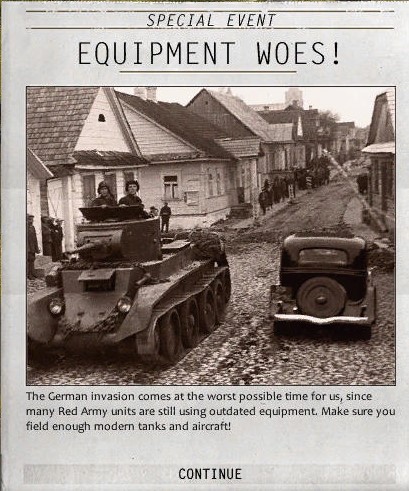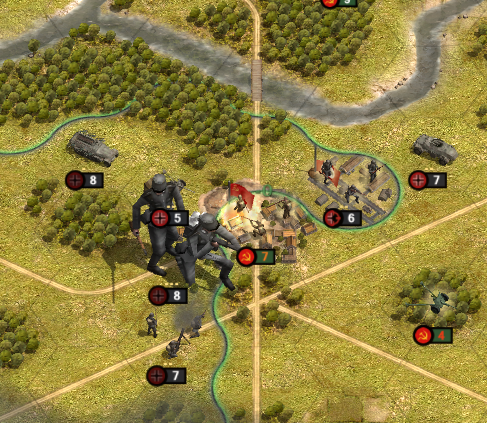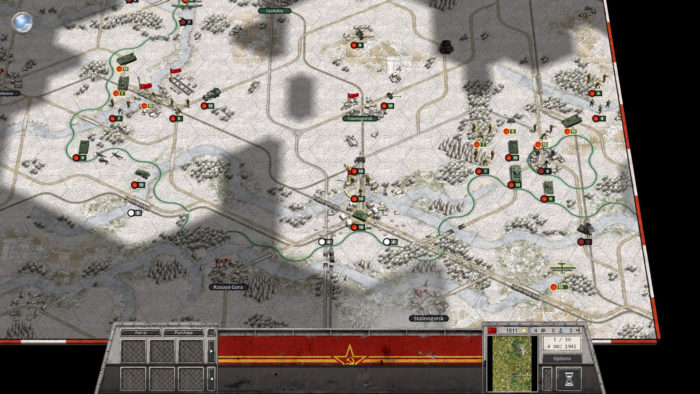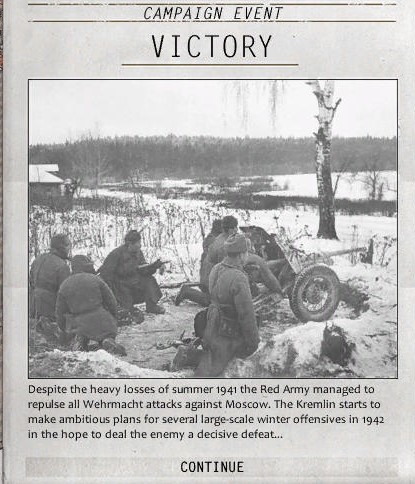Order of Battle – Red Star
Red Star is the twelfth scenario package for Order of Battle World War 2 and the first commanding Russian forces. This review is based on four completed Lieutenant level difficulty games played during the first three weeks of release. Red Star was purchased for $14.99 and played on a two-year-old Falcon Northwest Talon.
Avery Abernethy,
Red Star has thirteen scenarios starting in 1938 attacking the Japanese on the Changkufeng Heights during the battle of Lake Khasan in Manchuria. Japanese infantry control the heights supported by significant artillery, anti-tank, and anti-aircraft. The Japanese have superior infantry, but the Russians field BT-7 tanks, their best armor until T-34 tanks become available in 1941. The first battle is a slow, careful, grinding advance against entrenched defenders.
The next two battles are in 1939 at Khalkin Gol in Mongolia on a much larger map controlling more forces. Enemy air units make their first appearance. The first scenario is a large Japanese attack against AI controlled Russian forces in the center. Your forces are on the flanks and counter-attack the Japanese advance including recapturing several victory hexes. In the 2nd Battle of Khalkin Gol you command even more forces in a general advance against the Japanese.
Russian Armor and Air Units must be used carefully in both Khalkin Gol battles. Japanese anti-tank and anti-aircraft are deadly. Anti-tank guns can be concealed in villages or forests. A headlong armor advance ahead of supporting infantry risks destruction of your armored spearheads. Likewise, engaging Japanese air units in sectors covered by anti-aircraft may torch your fragile aircraft.
Next your forces invade Poland at the battle of Grodno in September 1939. Your Russian forces are overwhelming making this battle a tune-up for Finland.
The four battles against the Finns provide new challenges. Finnish ski units are difficult to spot, are exceptionally mobile, and are highly effective in flank attacks to isolate your forces. In contrast, the Japanese tend to concentrate their forces on attack or defense. Tactics yielding victory against the Japanese cause torment against the agile Finns who adore striking unprotected flanks.
The battles against Finland provide considerable variety. In two battles the Russians are attacking on large maps targeting distant cities. Having enough concentration of force along the main axis of attack while guarding your flanks is essential to success. In the 1939 battle of Summa the Russians are on defense against strong Finnish attacks. In the 1940 battle of Summa the Russians must attack strong defensive positions including extensive fortifications backed by heavy artillery.
The final five battles are against the Germans starting in 1941 with Rasainiai being attacked by Army Group North. The Russian player must upgrade all armor and aircraft to stand a chance. Infantry upgrades are also important. The Germans attack with strong combined arms forces including powerful fighter and tactical bomber formations. Assuming you survive Rasainiai, you must successfully defend Smolensk against Army Group Center on a massive map. I found Rasainiai and Smolensk the two toughest battles in the game.
The Russians then go on the offensive in Enlya (near Smolensk) and Rostov. Red Star concludes with the defense of Moscow which requires repelling two large German spearheads and then counter-attacking the weakened German survivors.
Red Star’s Strong Points
There is a lot to like with Red Star. You get to play the Soviets for the first time. The three battles in the border skirmishes against Japan have seldom been featured in computer wargames. Bringing under-covered battles of WW2 to your computer has been a strong point of the entire Order of Battle WW2 series.
The AI manages several things very well. As seen in earlier releases, the AI is very good on defense and the revised AI has significantly improved the ability to launch and sustain combined arms offenses. Better, the AI in Red Star can successfully attack using very different strategies.
When the Japanese attack, the AI uses brute force. The Japanese concentrate their infantry, armor and artillery to pound their way straight at main objectives. When the Finns attack, the AI uses the Finnish ski troops to excellent effect on flanking attacks. Ski troops are very fast, have high concealment, and will strike from the flanks. You must guard your flanks and garrison key victory cities or the AI Finns will make you suffer.
When the Germans attack you can expect the AI to launch combined arms attacks including the effective use of tactical bombers. The AI Germans hit hard, hit in waves, and often have reserves to exploit gaps torn in your lines. The AI will brutally isolate and destroy units. Even better, the AI has improved to the point where heavily damaged units which auto-retreated from ground attacks may be eliminated by follow-up tactical air attacks. The German AI will also withdraw heavily damaged units to reinforce them before throwing them back into battle. In contrast, the AI Japanese seldom retreat.
Having played every release in the order of battle series, the AI has significantly improved its ability to launch coordinated ground attacks. Like previous releases, the AI will effectively cut off and destroy units. Now, the updated AI has improved its ability to use sustained attacks. Notably, the Red Star AI attacks in a manner consistent with the differences in force composition and strategy employed by the Japanese, the Finns and the Germans.
I found the game to be challenging on the 2nd of five difficulty levels. I think players can find a difficulty level that will challenge their skills.
There is a good mix of scenarios from pure attack, pure defense, to defense/counter-attack scenarios. One of the better mix of scenarios from a range of battle perspective in the entire Order of Battle series.
Russian Tactical Bombers are poor compared to German and US/British counterparts at similar periods during the war. Eliminating almost destroyed units which retreated can be very frustrating. This puts an emphasis on encircling German units – which is itself risky. This is a feature and not a bug – and the Russian player has to balance their attacks and counterattacks very carefully. The AI is aggressive in picking off advance units lacking adequate flank protection.
Two smaller pluses to Red Star. Russian conscript troops are almost useless, just like they were in the Russian Army. I used mine to clear mine fields, sit in exposed positions to be easily spotted by enemy heavy artillery, and other means to get some use out of them before they died.
Last, the hypocrisy of the Soviet regime was incorporated into your orders. Examples include: “Since Finland rejected all of our demands for a buffer zone north of Leningrad, the Red Army has begun the invasion of Karella to settle the matter.” Your orders to invade Poland include: “To deflect a diplomatic backlash Moscow declares that we have to protect Ukrainians and Belarusians living in eastern Poland.”
You must, absolutely must, stockpile replacement/reinforcement points to win Red Star. I needed around 1,300 points to upgrade all fighters, tanks, and infantry for the first German Invasion scenario. If you lack the points to upgrade your tanks to T-34s, buy modern fighters, and purchase infantry upgrades the Nazis will utterly crush your forces. Pre-1941 fighters and tanks cannot compete against the Nazi onslaught. I played the game four times to confirm this point.
Second, you must be careful in using elite replacements prior to upgrading your forces for the German invasion in 1941. It is barely possible, if you are very careful, to substantially use elite replacements prior to 1941. Two of my replays were done to test this theory. However, I strongly recommend renaming all core units to avoid accidentally using elite reinforcements on non-core units and put yourself in the hole in 1941.
Red Star’s Shortcomings
The game almost forces an armor heavy core force on the player. Significant carrots are dangled which result in fielding armor heavy forces early in the war. This fits Soviet doctrine and did not bother me, but others may find it annoying.
Like other Order of Battle releases, in some scenarios the player does not control all Russian forces. This was done to simulate STAFKA requirements or split commands. This design decision irritated some players in previous releases.
The victory conditions in the Rostov scenario were bugged. I replicated this problem twice and the issue was discussed on the Slitherine forums. The designers are aware of the problem, a hotfix was released, and this will be corrected in the first patch. Still, this bug should have been eliminated during playtesting.
A very minor and totally weird “giant unit” bug was encountered in two scenarios. Giant snow Finns or giant storm Nazis would appear on turn one and then vanish. I had to move quickly to screen capture this for your amusement since the appearances are brief. There was no effect on play and this is more of a humorous Easter egg than a game flaw.
Players lacking the reinforcement/upgrade points to upgrade all units when the Germans invade will come to a quick end. Everything must be upgraded – infantry, and especially tanks and aircraft. German armor and fighters shred earlier units. This means foregoing less important upgrades in armor in earlier scenarios.
If you own previous scenarios you must download the updated core game. This occurs every time a new scenario package is released and this can take quite a while to download. Unless this is your first purchase in the Order of Battle series or if you buy a physical disk copy you cannot play the game without updating the core engine. The AI improvements are worth it – but it is a by now expected annoyance.
There is a problem with the improved AI which can be exploited. The AI is extremely aggressive on offense, which makes laying ambushes relatively easy. This is especially true for baiting German Fighters into ambushes backed by anti-aircraft guns. My “air ambush strategy” destroyed the German air advantage early in each scenario. This tactic can also be used against the Finns, who in some scenarios have significant air wings. I ended up using close to 100% fighter deployment of air command points in most scenarios just to deny the enemy the ability to bomb my units. Using this strategy, I was able to gain air parity (and sometimes superiority) when I should not be able to do so.
On the ground the Germans will attack too long when over-extended, yielding relatively easy counterattacks late in some scenarios. However, this is something that happened on the Eastern Front multiple times and may be a design decision.
Summary and Recommendation
Overall this is an excellent release. Red Star has one of the most challenging AIs out there on offense while retaining a good defensive AI. Red Star covers battles seldom if ever done on the computer. You get a lot of game play for your $15 and there is a wide variety of battles to play from straight offense, pure defense, and defense/counterattack scenarios. Your orders capture the depravity of the Soviet Communists. Improvements in the offensive AI can be made – but this one is a clear winner and well worth the $15 price.
Chat about it below, or in our forums, or hit our FaceBook page >>


